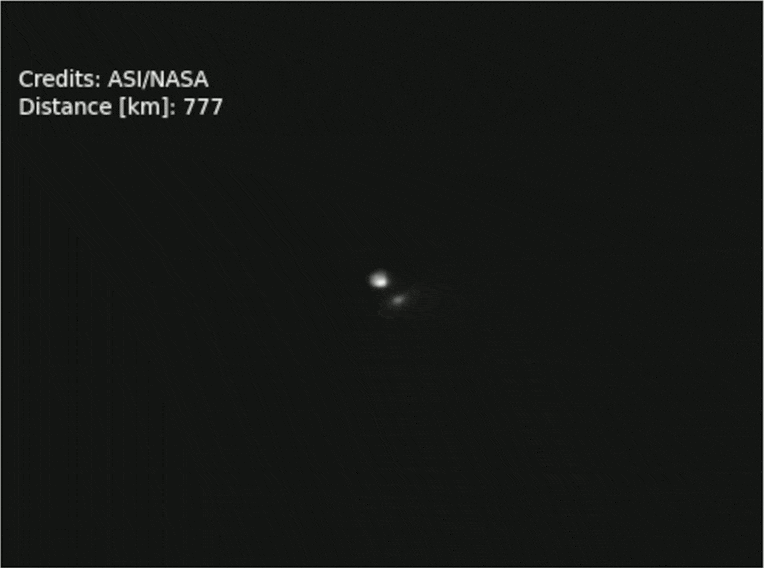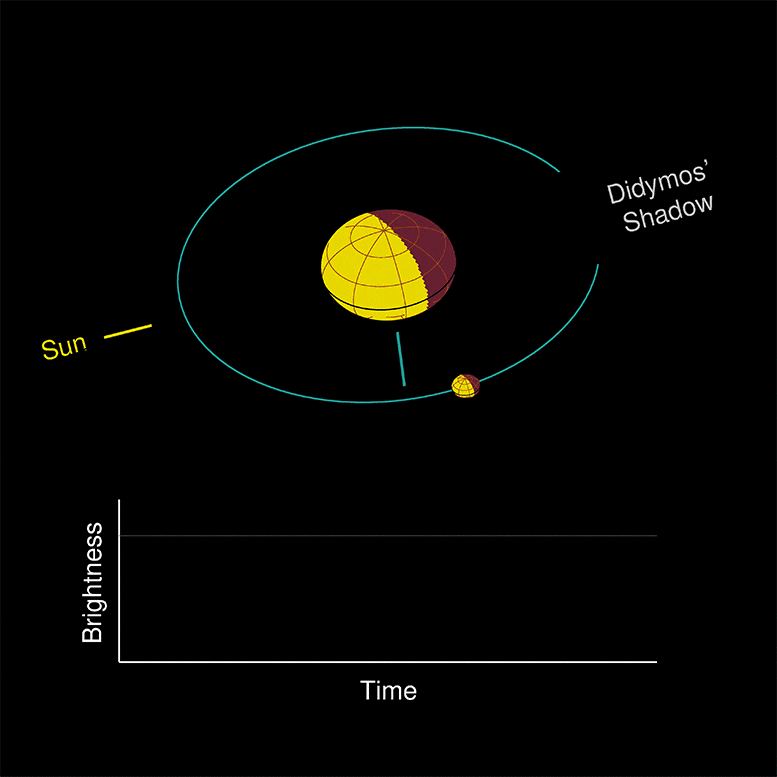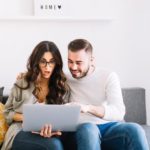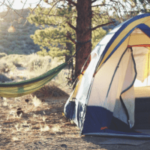
Esta imagen del telescopio espacial Hubble de la NASA tomada el 8 de octubre de 2022 muestra restos explosivos de la superficie de Demorphos 285 horas después de que el asteroide chocara deliberadamente con la nave espacial DART de la NASA el 26 de septiembre. La forma de esta cola ha cambiado con el tiempo. Los científicos continúan estudiando esta sustancia y cómo se mueve por el espacio, para comprender mejor el asteroide. Crédito: NASA/ESA/STScI/Hubble
El efecto dardo de la NASA logró cambiar la órbita del asteroide Demorphos
Analizar los datos obtenidos[{» attribute=»»>NASA’s Double Asteroid Redirection Test (DART) investigation team over the past two weeks reveals the spacecraft’s kinetic impact with its target asteroid, Dimorphos, successfully altered the asteroid’s orbit. This marks humanity’s first time purposely changing the motion of a celestial object and the first full-scale demonstration of asteroid deflection technology for planetary defense.
“All of us have a responsibility to protect our home planet. After all, it’s the only one we have,” said NASA Administrator Bill Nelson. “This mission shows that NASA is trying to be ready for whatever the universe throws at us. NASA has proven we are serious as a defender of the planet. This is a watershed moment for planetary defense and all of humanity, demonstrating commitment from NASA’s exceptional team and partners from around the world.”

This movie uses images from the LUKE camera on ASI’s LICIACube, captured just after the impact of NASA’s Double Asteroid Redirect Test, or DART, spacecraft with the asteroid Dimorphos on September 26, 2022. The video begins with LICIACube around 500 miles away from the asteroid, passes by, and then continues to around 200 miles away. The video clearly shows the ejection of material streaming off of Dimorphos due to the impact. Credit: ASI/NASA
Prior to DART’s impact, it took Dimorphos 11 hours and 55 minutes to orbit Didymos, its larger parent asteroid. Since DART’s intentional collision with Dimorphos on September 26, astronomers have been using telescopes on Earth to measure how much that time has changed. Now, the investigation team has confirmed the spacecraft’s impact altered Dimorphos’ orbit around Didymos by 32 minutes, shortening the 11-hour and 55-minute orbit to 11 hours and 23 minutes. This measurement has a margin of uncertainty of approximately plus or minus 2 minutes.
Before its encounter, NASA had defined a minimum successful orbit period change of Dimorphos as a change of 73 seconds or more. This early data indicates that DART surpassed this minimum benchmark by more than 25 times.

ASI’s LICIACube satellite acquired this image just before its closest approach to the Dimorphos asteroid, after the Double Asteroid Redirect Test, or DART mission, purposefully made impact on September 26, 2022. Didymos, Dimorphos, and the plume coming off of Dimorphos after DART impact are clearly visible. Credit: ASI/NASA

ASI’s LICIACube satellite acquired this image just after its closest approach to the Dimorphos asteroid, after the Double Asteroid Redirect Test, or DART mission, made impact on September 26, 2022. In this image, it is possible to observe the Didymos and Dimorphos from a different perspective, which can be useful to determine the shapes of the asteroids. Credit: ASI/NASA
“This result is one important step toward understanding the full effect of DART’s impact with its target asteroid,” said Lori Glaze, director of NASA’s Planetary Science Division at NASA Headquarters in Washington. “As new data come in each day, astronomers will be able to better assess whether, and how, a mission like DART could be used in the future to help protect Earth from a collision with an asteroid if we ever discover one headed our way.”

This image taken by the SOAR Telescope in Chile, operated by NSF’s NOIRLab, shows a side view of the streams of material from the surface of Dimorphos — captured two days after the asteroid was intentionally impacted by NASA’s DART spacecraft. On the right, the material is forming a more than 6,000-mile-long comet-like tail, pushed into shape by pressure from the Sun’s radiation. Credit: CTIO/NOIRLab/SOAR/NSF/AURA/T. Kareta (Lowell Observatory), M. Knight (US Naval Academy), Image processing: T.A. Rector (University of Alaska Anchorage/NSF’s NOIRLab), M. Zamani & D. de Martin (NSF’s NOIRLab)
The investigation team is still acquiring data using ground-based observatories around the world – as well as with radar facilities at NASA Jet Propulsion Laboratory’s Goldstone planetary radar in California and the National Science Foundation’s Green Bank Observatory in West Virginia. They are updating the period measurement with frequent observations to improve its precision.

This animation shows a highly magnified view of how Dimorphos’ orbit around Didymos is seen from Earth, approximately one week after the DART impact. Each time around the orbit, Dimorphos passes through the shadow cast by Didymos, and half an orbit later, briefly casts a shadow onto Didymos. In reality, only the combined light from both asteroids can be seen by telescopes. The graph shows how the total brightness dips slightly when either body is shadowed by the other. DART astronomers measure the time intervals between the dips that mark these eclipse events in order to determine the new period of the orbit. Credit: NASA/APL/UMD
Focus now is shifting toward measuring the efficiency of momentum transfer from DART’s roughly 14,000-mile (22,530-kilometer) per hour collision with its target. This includes further analysis of the “ejecta” – the many tons of asteroidal rock displaced and launched into space by the impact. The recoil from this blast of debris substantially enhanced DART’s push against Dimorphos – a little like a jet of air streaming out of a balloon sends the balloon in the opposite direction.

This chart offers insight into data the DART team used to determine the orbit of Dimorphos after impact – specifically, small reductions in brightness due to eclipses of Didymos and Dimorphos. The new observations show the Dimorphos eclipses occur at different times (green arrows) than if the period were unchanged (gray arrows). The top timeline shows observations the DART team used to determine Dimorphos’ new orbital period, with two sets of that data (from September 29, 2022, and October 4, 2022) shown in detail. The observed decreases in relative brightness for each night’s dataset correspond to Dimorphos eclipses from a new orbital period of 11 hours and 23 minutes – demonstrating that the eclipse timing differs from pre-impact period of 11 hours and 55 minutes. Credit: NASA/Johns Hopkins APL/Astronomical Institute of the Academy of Sciences of the Czech Republic/Lowell Observatory/JPL/Las Cumbres Observatory/Las Campanas Observatory/European Southern Observatory Danish (1.54-m) telescope/University of Edinburgh/The Open University/Universidad Católica de la Santísima Concepción/Seoul National Observatory/Universidad de Antofagasta/Universität Hamburg/Northern Arizona University
To successfully understand the effect of the recoil from the ejecta, more information on the asteroid’s physical properties, such as the characteristics of its surface, and how strong or weak it is, is needed. These issues are still being investigated.
Vistas del sistema binario de asteroides Didymos y Dimorphos obtenidas de instalaciones de radar en el Goldstone Radar del Laboratorio de Propulsión a Chorro de la NASA en California y el Observatorio Green Bank de la Fundación Nacional de Ciencias en Virginia Occidental. Mostrado a la izquierda 4 de octubre de 2022, billetes de Goldstone Notes; A la derecha, recopilado por las observaciones de Goldstone y Green Bank del 9 de octubre de 2022. El eje vertical muestra el alcance del radar, o la distancia desde el suelo, y el eje horizontal muestra Doppler, o la línea de visión. La última diapositiva de la película muestra la diferencia entre el lugar donde se observó Demorphos y el lugar donde habría estado con la órbita original. Crédito: NASA/Johns Hopkins APL/[{» attribute=»»>JPL/NASA JPL Goldstone Planetary Radar/National Science Foundation’s Green Bank Observatory
“DART has given us some fascinating data about both asteroid properties and the effectiveness of a kinetic impactor as a planetary defense technology,” said Nancy Chabot, the DART coordination lead from the Johns Hopkins Applied Physics Laboratory (APL) in Laurel, Maryland. “The DART team is continuing to work on this rich dataset to fully understand this first planetary defense test of asteroid deflection.”

The bright line across the middle of these images, shows the asteroid Didymos. The images are views of the Didymos and Dimorphos binary asteroid system obtained from radar facilities at NASA Jet Propulsion Laboratory’s Goldstone planetary radar in California and the National Science Foundation’s Green Bank Observatory in West Virginia. Shown at left are October 4, 2022, observations from Goldstone observations; at right are combined Goldstone and Green Bank observations from October 9, 2022.
Credit: NASA/Johns Hopkins APL/JPL/NASA JPL Goldstone Planetary Radar/National Science Foundation’s Green Bank Observatory

The yellow box shows the asteroid Didymos. The images are views of the Didymos and Dimorphos binary asteroid system obtained from radar facilities at NASA Jet Propulsion Laboratory’s Goldstone planetary radar in California and the National Science Foundation’s Green Bank Observatory in West Virginia. Shown at left are October 4, 2022, observations from Goldstone observations; at right are combined Goldstone and Green Bank observations from October 9, 2022.
Credit: NASA/Johns Hopkins APL/JPL/NASA JPL Goldstone Planetary Radar/National Science Foundation’s Green Bank Observatory

The green circle shows the location of the Dimorphos asteroid, which orbits the larger asteroid, Didymos, seen here as the bright line across the middle of the images. The images show the Didymos and Dimorphos binary asteroid system obtained from radar facilities at NASA Jet Propulsion Laboratory’s Goldstone planetary radar in California and the National Science Foundation’s Green Bank Observatory in West Virginia. Shown at left are October 4, 2022, observations from Goldstone observations; at right are combined Goldstone and Green Bank observations from October 9, 2022.
Credit: NASA/Johns Hopkins APL/JPL/NASA JPL Goldstone Planetary Radar/National Science Foundation’s Green Bank Observatory

The green circle shows the location of the Dimorphos asteroid, which orbits the larger asteroid, Didymos, seen here as the bright line across the middle of the images. The blue circle shows where Dimorphos would have been had its orbit not changed due to NASA’s DART mission purposefully impacting the smaller asteroid on September 26, 2022. The images show the Didymos and Dimorphos binary asteroid system obtained from radar facilities at NASA Jet Propulsion Laboratory’s Goldstone planetary radar in California and the National Science Foundation’s Green Bank Observatory in West Virginia. Shown at left are October 4, 2022, observations from Goldstone observations; at right are combined Goldstone and Green Bank observations from October 9, 2022.
Credit: NASA/Johns Hopkins APL/JPL/NASA JPL Goldstone Planetary Radar/National Science Foundation’s Green Bank Observatory

The images show a series of radar images captured at different times on October 9, 2022, of the Didymos and Dimorphos binary asteroid system obtained from radar facilities at NASA Jet Propulsion Laboratory’s Goldstone planetary radar in California and the National Science Foundation’s Green Bank Observatory in West Virginia. Dimorphos, the smaller of the two asteroids, is circled in green. Didymos is seen as the brighter stripe across the middle.
Credit: NASA/Johns Hopkins APL/JPL/NASA JPL Goldstone Planetary Radar/National Science Foundation’s Green Bank Observatory
For this analysis, astronomers will continue to study imagery of Dimorphos from DART’s terminal approach and from the Light Italian CubeSat for Imaging of Asteroids (LICIACube), provided by the Italian Space Agency, to approximate the asteroid’s mass and shape. Roughly four years from now, the European Space Agency’s Hera project is also planned to conduct detailed surveys of both Dimorphos and Didymos, with a particular focus on the crater left by DART’s collision and a precise measurement of Dimorphos’ mass.

This image from ASI’s LICIACube show the plumes of ejecta streaming from the Dimorphos asteroid after NASA’s Double Asteroid Redirect Test, or DART, mission, made impact with it on September 26, 2022. Each rectangle represents a different level of contrast in order to better see fine structure in the plumes. By studying these streams of material, we will be able to learn more about the asteroid and the impact process. Credit: ASI/NASA/APL
Johns Hopkins APL built and operated the DART spacecraft and manages the DART mission for NASA’s Planetary Defense Coordination Office as a project of the agency’s Planetary Missions Program Office. Telescopic facilities contributing to the observations used by the DART team to determine this result include: Goldstone, Green Bank Observatory, Swope Telescope at the Las Campanas Observatory in Chile, the Danish Telescope at the La Silla Observatory in Chile, and the Las Cumbres Observatory global telescope network facilities in Chile and in South Africa.
Neither Dimorphos nor Didymos poses any hazard to Earth before or after DART’s controlled collision with Dimorphos.

«Aficionado a la comida. Aspirante a emprendedor. Comunicador. Introvertido. Jugador. Analista. Fanático de la Web. Gurú del alcohol de toda la vida. Explorador».











More Stories
México, Chile, España y Argentina encabezan la lista de los 10 originales en español más vistos en Prime Video
La película “La magnífica cosechadora de oro” destaca la lucha emocional de un hijo para ayudar a su padre enfermo en Chile (exclusivo)
Fabrizio Cubano utiliza la comedia para abordar la política